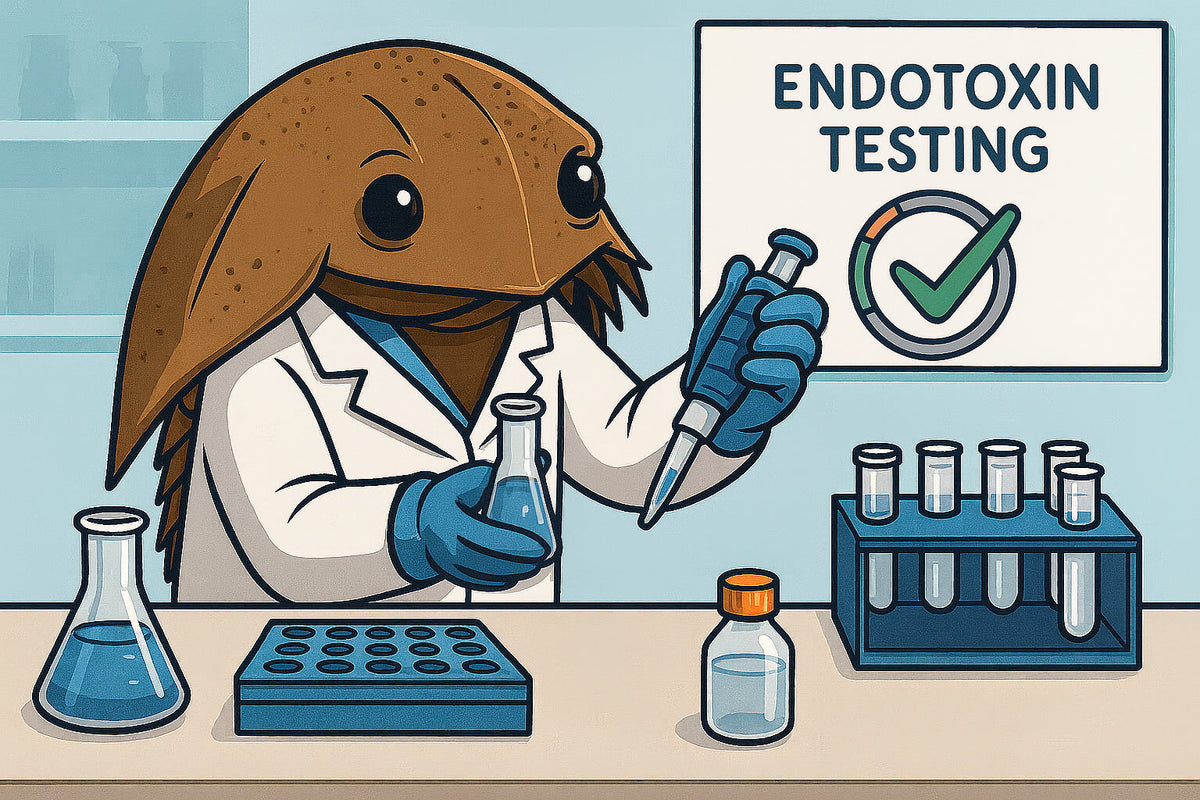
Endotoxin Testing & Control in Plasmid Manufacturing
|
|
Time to read 5 min
|
|
Time to read 5 min
Endotoxin testing confirms plasmids meet strict purity requirements.
Regulatory standards often require <0.1 EU/µg for therapeutic-grade plasmid DNA.
Upstream processing and downstream purification decisions significantly impact endotoxin burden.
Sensitive LAL testing is the gold standard for measuring endotoxin contamination.
LAL is typically derived from horseshoe crab blood, while rFC assays provide a synthetic alternative.
When producing plasmids for advanced research or therapeutic use, controlling endotoxin levels is as crucial as ensuring sequence accuracy or high yield. Achieving low endotoxin levels requires a combination of thoughtful design, upstream processing, and precise downstream purification. These principles, while drawn from clinical and GMP practices, also offer significant value to research teams aiming for high-performance, reproducible results.
This article explores what endotoxins are, how they’re measured, and the strategies used to ensure plasmid DNA is clean and safe for advanced research and therapeutic development.
Need help producing plasmids with <0.1 EU/µg endotoxin levels?
Sign up for our purification service. Our high-quality plasmid preparations are designed with these standards in mind, ensuring they’re reliable, reproducible, and ready for demanding workflows.
Endotoxins are lipopolysaccharides (LPS) from the outer membranes of Gram-negative bacteria like E. coli, which is widely used for plasmid production. While these molecules are harmless in the bacterial host, they can cause strong immune reactions in mammals, leading to inflammation or fever. Even trace amounts of endotoxin contamination can disrupt experiments, reduce transfection efficiency, and cause adverse biological effects.
To monitor and control endotoxin levels, scientists use tests such as the LAL assay or recombinant Factor C assays. These tests quantify contamination in endotoxin units (EU) per microgram of DNA, providing a reliable benchmark for plasmid purity.
Limulus Amebocyte Lysate (LAL) testing is the most widely used method for detecting endotoxins. It relies on the blood of the horseshoe crab (Limulus polyphemus), which contains specialized amebocyte cells that clot in the presence of endotoxins—a natural defense mechanism against bacterial infections.
When exposed to plasmid samples, the LAL reagent reacts with any endotoxins present, forming a gel-like clot or producing a measurable color change, depending on the test format.
There are three main LAL test types:
As an alternative, recombinant Factor C (rFC) assays have been developed to avoid harvesting horseshoe crab blood. These assays use a synthetic version of the clotting enzyme triggered by endotoxins, offering high sensitivity with improved sustainability.
This testing is an essential part of QA/QC pipelines, ensuring plasmid batches meet the stringent specifications required for advanced research and therapeutic studies.
Regulatory bodies like the FDA and EMA have set strict limits for endotoxins in products destined for clinical use, typically <0.1 EU/µg DNA.
However, even for research-grade plasmids, minimizing endotoxin contamination improves reproducibility and safety, particularly for transfection of sensitive cell types or in vivo studies.
These thresholds are based on decades of research showing that endotoxins can trigger immune system overactivation at very low levels. As a result, both manufacturing processes and quality control systems are built around reducing endotoxin presence as much as possible.
Endotoxin control starts with smart upstream processing, which sets the foundation for clean plasmid production. Since endotoxins originate from E. coli, strain selection is key — certain strains are engineered to produce lower levels of endotoxin, minimizing the burden on purification systems. Fermentation control also matters: carefully monitored growth conditions reduce spontaneous cell lysis, which releases endotoxins into the culture medium.
Using endotoxin-free reagents and buffers during fermentation and cell lysis further limits contamination risks. These proactive upstream measures make downstream purification more efficient and help achieve ultra-low endotoxin targets.
Even with careful upstream processing, purification steps are necessary to eliminate residual endotoxins. Some of the most effective downstream methods include:
By combining these techniques, plasmid DNA can consistently achieve <0.1 EU/µg endotoxin levels, suitable for demanding research or therapeutic contexts.
Endotoxin control is a multi-step process that begins with bacterial strain selection and extends through fermentation, purification, and rigorous testing. By combining proactive upstream strategies, advanced downstream purification, and sensitive LAL or rFC assays, plasmids can achieve the ultra-low endotoxin levels required for reliable experimental outcomes and therapeutic research.
Need plasmids with <0.1 EU/µg endotoxin levels? Our team of plasmid experts is ready to assist. Reach out today to streamline your research.
Endotoxins chemical composition
FDA Technical Guide: Bacterial Endotoxins/Pyrogens
Horseshoe crabs have a unique immune response where amebocytes clot upon detecting bacterial endotoxins, making them ideal for highly sensitive testing.
Yes. Recombinant Factor C (rFC) assays have equivalent sensitivity and reproducibility while avoiding animal-based harvesting.
Bacterial strain choice, culture conditions, and the quality of media or buffers all influence how much endotoxin is released during growth and lysis.
Endotoxins bind strongly to plasmid DNA, making them difficult to remove; they can also reduce transfection performance if not effectively removed.
Even for basic cell culture, endotoxin-free plasmids reduce variability, minimize cell stress, and improve reproducibility of results.